|
|
 USB Power Delivery 2.0 introduced some changes to the way that power ratings between devices are handled, making the standard more flexible than before. The old set of Power Profiles were removed in PD 2.0 and replaced by Power Rules that allow for a wider range of current negotiations. The USB 3.1 specification adopted Power Profiles instead, but is only rated up to 15W rather than 100W.
USB Power Delivery 2.0 introduced some changes to the way that power ratings between devices are handled, making the standard more flexible than before. The old set of Power Profiles were removed in PD 2.0 and replaced by Power Rules that allow for a wider range of current negotiations. The USB 3.1 specification adopted Power Profiles instead, but is only rated up to 15W rather than 100W.
PD 3.0 made some tweaks to enhance power delivery, but the Power Rules are the same as PD 2.0 products. Rules are split into four target power categories; 7.5W, >15W, >27W, and >45W; each of which offers a range of voltage and current configurations. Sources supplying more than 15 watts offer voltages of 5 and 9 volts, those supplying more than 27 watts offer 5, 9 and 15 volts, and those supplying more than 45 watts offer 5, 9, 15 and 20 volts. The maximum 100W power supply is achieved with 20V and up to 5A, although all of the other modes cap out at 3A, depending on the required power.
• Increased power levels from existing USB standards up to 100W.
• The power direction is no longer fixed. This enables the product with the power (Host or Peripheral) to provide the power.
• Optimize power management across multiple peripherals by allowing each device to take only the power it requires, and to get more power when required for a given application.
• Intelligent and flexible system-level management of power via optional hub communication with the PC.
• It allows low power cases such as headsets to negotiate for only the power they require. |
| |
| Read more about Charging: Power Delivery |
SHOW PRODUCTS |
|
|
|
|
|
 Qi (pronounced/ CHEE from the Chinese word qi) is an open interface standard that defines wireless power transfer using inductive charging over distances of up to 4 cm (1.6 inches), developed by the Wireless Power Consortium. The system uses a charging pad and a compatible device, which is placed on top of the pad, charging via resonant inductive coupling.
Qi (pronounced/ CHEE from the Chinese word qi) is an open interface standard that defines wireless power transfer using inductive charging over distances of up to 4 cm (1.6 inches), developed by the Wireless Power Consortium. The system uses a charging pad and a compatible device, which is placed on top of the pad, charging via resonant inductive coupling.
Version 1.0 - 2010 up to 5 Watt
Version 1.1 - 2012 up to 5 Watt
Version 1.2 - 2015 up to 15 Watt |
| |
| Read more about Charging: Qi wireless charging standard |
SHOW PRODUCTS |
|
|
|
|
|
 If you’re new to the concept of quick charging, the result is in the name: your smartphone charges up faster than it would without Quick Charge technology.
If you’re new to the concept of quick charging, the result is in the name: your smartphone charges up faster than it would without Quick Charge technology.
Qualcomm boasts a fourfold increase in charging times over conventional chargers with Quick Charge 3.0, up from the 40 percent speed increase offered by its first-generation technology. However, one of the interesting things to note is that Qualcomm isn’t touting massive increases in charging times over version 2.0, instead, the company is focusing on improved efficiency this time around.
Voltage
• 3.6 V to 22 V, dynamic with 200 mV increments
Max current
• 2.6 A or 4.6 A
Max power
• 36 W (12 V x 3 A)
The major new feature with 3.0 is INOV (Intelligent Negotiation for Optimum Voltage), which allows for a fined tuned power output and a more optimized charging cycle. Firstly, different batteries require different charging voltages. Version 2.0 supported four modes at varying power levels, 5 volts/2amps, 9V/2A, 12V/1.67A, and a 20 volt option. Quick Charge 3.0’s INOV communicates with the device to request any voltage between 3.2V and 20V at 200mV increments, allowing for a wider selection of voltages.
Importantly, Qualcomm has retained backward compatibility with its 2.0 and 1.0 standards. As the power draw is handled on the smartphone side, you will safely receive the maximum amount of power for your device using any of the certified chargers. However, you won’t achieve full charging speeds if you try charging newer phones with older lower power chargers.
Although Qualcomm supports Quick Charge in all of its new SoCs, it is still up to smartphone and tablet manufacturers to implement the specific circuitry required to make full use of the fastest charging speeds available. |
| |
| Read more about Charging: Quick Charge 3.0 |
SHOW PRODUCTS |
|
|
|
|
|
 Dante is an audio networking technology developed by Audionate. Dante devices on the same network automatically detect each other. This can make setting up a system simpler and thus reduce complexity and potential errors. In this sense, Dante can be thought of as a plug-and-play network technology.
Dante is an audio networking technology developed by Audionate. Dante devices on the same network automatically detect each other. This can make setting up a system simpler and thus reduce complexity and potential errors. In this sense, Dante can be thought of as a plug-and-play network technology. |
| |
| Read more about Dante® link |
SHOW PRODUCTS |
|
|
|
|
|
 The initial versions of DisplayPort, 1.0 through 1.1a, were approved between May 2006 and January 2008. They provided a maximum bandwidth of 10.8 Gbit/s over a 4-lane main link, with cables up to 2 meters in length required for full bandwidth support.
The initial versions of DisplayPort, 1.0 through 1.1a, were approved between May 2006 and January 2008. They provided a maximum bandwidth of 10.8 Gbit/s over a 4-lane main link, with cables up to 2 meters in length required for full bandwidth support.
DP version 1.1 allowed for alternative link layers, like fiber optic, enabling longer reach without signal degradation. Additionally, HDCP and DisplayPort Content Protection were included. |
| |
| Read more about Displayport 1.1 – High Speed (HBR1 up to 10,8 Gbit/s) |
SHOW PRODUCTS |
|
|
|
|
|
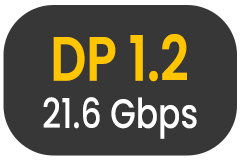 DisplayPort (DP) version 1.2, launched in 2010, brought several enhancements to the standard for monitor connections. The update increased the maximum data rate, allowed higher resolutions and refresh rates, and supported multiple screens through MST. It also included support for 3D and improved synchronization between audio and video. DisplayPort Version 1.2a, released in 2013, included Adaptive Sync, from which AMD's advanced FreeSync derived. Adaptive Sync was later integrated as an optional feature in the DisplayPort standard.
DisplayPort (DP) version 1.2, launched in 2010, brought several enhancements to the standard for monitor connections. The update increased the maximum data rate, allowed higher resolutions and refresh rates, and supported multiple screens through MST. It also included support for 3D and improved synchronization between audio and video. DisplayPort Version 1.2a, released in 2013, included Adaptive Sync, from which AMD's advanced FreeSync derived. Adaptive Sync was later integrated as an optional feature in the DisplayPort standard. |
| |
| Read more about Displayport 1.2 – High Speed (HBR2 up to 21,6 Gbit/s) |
SHOW PRODUCTS |
|
|
|
|
|
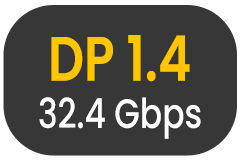 DisplayPort Version 1.3, approved in September 2014, enhances transmission bandwidth to 32.4 Gbit/s with the new HBR3 mode, enabling higher-resolution displays and faster refresh rates. This accommodates 4K UHD at 120 Hz, 5K at 60 Hz, or 8K at 30 Hz.
DisplayPort Version 1.3, approved in September 2014, enhances transmission bandwidth to 32.4 Gbit/s with the new HBR3 mode, enabling higher-resolution displays and faster refresh rates. This accommodates 4K UHD at 120 Hz, 5K at 60 Hz, or 8K at 30 Hz.
The standard supports driving multiple displays and includes Dual-mode for DVI and HDMI adapters. Thunderbolt 3 was intended to include DisplayPort 1.3 but ended up with version 1.2. Adaptive Sync remains optional. DisplayPort Version 1.4, released in March 2016, maintains HBR3 as the highest mode and introduces support for features like Display Stream Compression, HDR10 metadata, and expanded audio channels. |
| |
| Read more about Displayport 1.4 – High Speed (HBR3 up to 32,4 Gbit/s) |
SHOW PRODUCTS |
|
|
|
|
|
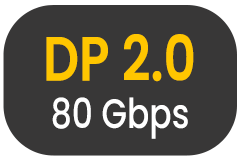 VESA released the DisplayPort 2.0 standard June 2019. This version marks the first major update since March 2016 and increases the data rate by approximately 3 times (from 25.92 to 77.37 Gbit/s) compared to the previous version (1.4a).
VESA released the DisplayPort 2.0 standard June 2019. This version marks the first major update since March 2016 and increases the data rate by approximately 3 times (from 25.92 to 77.37 Gbit/s) compared to the previous version (1.4a).
DisplayPort 2.0 introduces new capabilities to address future performance requirements for traditional displays, including support for resolutions beyond 8K, higher refresh rates, and HDR support at higher resolutions.
Configuration options include single display resolutions up to 16K at 60 Hz with 10 bpc RGB/Y'CBCR 4:4:4 color, or dual display resolutions with two 8K displays at 120 Hz. With DisplayPort 2.0's increased bandwidth, VESA offers a high degree of flexibility and configuration options for higher resolutions and refresh rates. |
| |
| Read more about Displayport 2.0 – High Speed (UHBR up to 80 Gbit/s) |
SHOW PRODUCTS |
|
|
|
|
|
 VESA announced DisplayPort version 2.1 in October 2022. This update introduces DP40 and DP80 cable certifications to ensure proper operation at speeds of 40 Gbit/s, UHBR13,5 (54 Gbit/s) and 80 Gbit/s, respectively, as introduced in version 2.0. It also revises electrical requirements to better integrate with USB4.
VESA announced DisplayPort version 2.1 in October 2022. This update introduces DP40 and DP80 cable certifications to ensure proper operation at speeds of 40 Gbit/s, UHBR13,5 (54 Gbit/s) and 80 Gbit/s, respectively, as introduced in version 2.0. It also revises electrical requirements to better integrate with USB4.
DisplayPort 2.1 aligns more closely with USB Type-C and USB4 PHY specifications, enabling a common PHY for both DisplayPort and USB4. Additionally, it adds a new bandwidth management feature to facilitate more efficient coexistence with other I/O data traffic over USB4. |
| |
| Read more about Displayport 2.1 – High Speed (UHBR up to 80 Gbit/s, USB4) |
SHOW PRODUCTS |
|
|
|
|
|
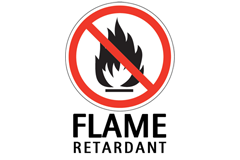 The cable material is made of flame-retardant material and is therefore suitable for network installations in public and commercial buildings, schools, institutions, etc., as there are high requirements for cable installations to be flame-retardant or their reaction to fire according to the latest fire regulation, as described in the Construction Products Regulation EN 50575 "Power, signal, and communication cables. Cables for general application in construction works subject to reaction to fire requirements".
The cable material is made of flame-retardant material and is therefore suitable for network installations in public and commercial buildings, schools, institutions, etc., as there are high requirements for cable installations to be flame-retardant or their reaction to fire according to the latest fire regulation, as described in the Construction Products Regulation EN 50575 "Power, signal, and communication cables. Cables for general application in construction works subject to reaction to fire requirements".
The cables must also meet the requirements for a new European fire classification, determined by tests of energy content, acid formation, heat release, smoke production, droplet formation, and fire spread. The existing fire classes will be replaced with seven new categories from A to F, as detailed in the standard.
Typically, an exemption can only be given for 10% of the cables that are not flame-retardant in commercial buildings. However, to facilitate the work, it is therefore easiest to "simply" choose cables with the right approvals, within both power, network, speaker, and data cables for all fixed installations, when building new or modernizing.
The EN 50575 standard as a book is not free, but can be purchased online from official stores. |
| |
| |
SHOW PRODUCTS |
|
|
|
|
|
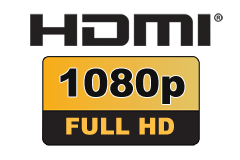 HDMI 1.4 supports a resolution up to 3840x2160 at 30 Hz and 1920x1080 at 120 Hz. At the same time, there is support for ARC, 3D, CEC management and more.
HDMI 1.4 supports a resolution up to 3840x2160 at 30 Hz and 1920x1080 at 120 Hz. At the same time, there is support for ARC, 3D, CEC management and more.
Note that HDMI 1.4 does not have the capability to support HDR. |
| |
| |
SHOW PRODUCTS |
|
|
|
|
|
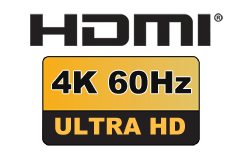 The product is ready and compatible with the newest version of Ultra HD with 4K 60 Hz support including HDCP 2.2, which is a technology for preventing illegal copying of 4K UHD content. Every piece of equipment in a setup must support HDCP 2.2 for a signal with this coding to pass through.
The product is ready and compatible with the newest version of Ultra HD with 4K 60 Hz support including HDCP 2.2, which is a technology for preventing illegal copying of 4K UHD content. Every piece of equipment in a setup must support HDCP 2.2 for a signal with this coding to pass through. |
| |
| |
SHOW PRODUCTS |
|
|
|
|
|
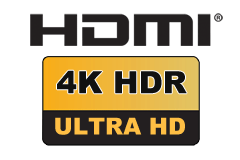 The product supports 4K resolution and HDR (High Dynamic Range), which has a greater separation of color nuances, giving a wider pallette to colorize the image, and this resulting on more vibrant and lifelike colors.
The product supports 4K resolution and HDR (High Dynamic Range), which has a greater separation of color nuances, giving a wider pallette to colorize the image, and this resulting on more vibrant and lifelike colors. |
| |
| |
SHOW PRODUCTS |
|
|
|
|
|
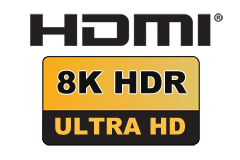 There is support for resolutions up to 7680x4320 as well as HDR.
There is support for resolutions up to 7680x4320 as well as HDR. |
| |
| |
SHOW PRODUCTS |
|
|
|
|
|
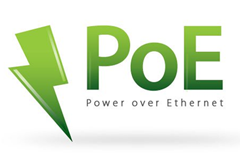 Power over Ethernet (PoE, EEE 802.3af-2003) is a cleber standard to supply ethernet connected devices, with power up to 15,4 Watt per PoE network switch port. The supply voltage are transmitted within the same ethernet cables as the data stream, and thereby only one CAT cable is needed, for e.g. IP cameras, Wi-Fi access points, door stations etc. The PoE standarden has been further developed into the PoE Plus/+ version (IEEE 802.3at-2009), which can delivery up to 25,5 Watt pr. connection, and are often utilized for HD network IP cameras.
Power over Ethernet (PoE, EEE 802.3af-2003) is a cleber standard to supply ethernet connected devices, with power up to 15,4 Watt per PoE network switch port. The supply voltage are transmitted within the same ethernet cables as the data stream, and thereby only one CAT cable is needed, for e.g. IP cameras, Wi-Fi access points, door stations etc. The PoE standarden has been further developed into the PoE Plus/+ version (IEEE 802.3at-2009), which can delivery up to 25,5 Watt pr. connection, and are often utilized for HD network IP cameras.
We recommends minimum Category 6 or 6A ethernet cables for a stable connection of PoE network equipment. |
| |
| Read more about PoE – Power over Ethernet |
SHOW PRODUCTS |
|
|
|
|
|
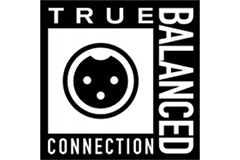 Balanced audio connections are usually known from the professional sector like recording studios or live concerts. It is very important to have a stable & interference free connection, as these signals will be highly amplified. The same applies to the connection from your turntable to the phono preamplifier. The big advantage of a balanced connection is its ability to remove picked up noise and interferences. And best of all, cartridges by nature are already balanced signal transducers! With True Balanced your are simply using everything, literally everything, that your cartridge is picking up from the record groove - To ensure the best connection to your phono preamplifier Pro-Ject designed their 'True Balanced Connection'
Balanced audio connections are usually known from the professional sector like recording studios or live concerts. It is very important to have a stable & interference free connection, as these signals will be highly amplified. The same applies to the connection from your turntable to the phono preamplifier. The big advantage of a balanced connection is its ability to remove picked up noise and interferences. And best of all, cartridges by nature are already balanced signal transducers! With True Balanced your are simply using everything, literally everything, that your cartridge is picking up from the record groove - To ensure the best connection to your phono preamplifier Pro-Ject designed their 'True Balanced Connection' |
| |
| |
SHOW PRODUCTS |
|
|
|
|
|
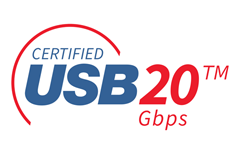 USB4 is based on the Thunderbolt 3 protocol specification. It supports 20 Gbit/s throughputs, is compatible with Thunderbolt 3, and backward compatible with USB 3.2 and USB 2.0.
USB4 is based on the Thunderbolt 3 protocol specification. It supports 20 Gbit/s throughputs, is compatible with Thunderbolt 3, and backward compatible with USB 3.2 and USB 2.0.
The architecture defines a method to share a single high-speed link with multiple end device types dynamically that best serves the transfer of data by type and application.
USB4™ identifies two transfer rates, USB4™ 20Gbps at 20Gbps and USB4™ 40Gbps at 40Gbps.
Marketing name: USB4™ 20Gbps
• Product capability: product signals at 20Gbps
Marketing name: USB4™ 40Gbps
• Product capability: product signals at 40Gbps
USB4™ Key Points:
• Two-lane operation using existing USB Type-C® cables
• Doubles the bandwidth to extend USB Type-C® performance
• Up to 40Gbps operation over 40Gbps-certified cables
• Enables multiple simultaneous data and display protocols
• Multiple data and display protocols efficiently share the total available bus bandwidth
• USB4™ hosts can optimally scale allocations for display data flow
• Backward compatibility with USB 3.2, USB 2.0 and Thunderbolt 3
The USB4™ specification compliments and build upon the existing USB 3.2 and USB 2.0 specifications. The USB4™ architecture defines a method to share a single high-speed link with multiple end device types dynamically that best serves the transfer of data by type and application.
As the USB Type-C® connector has evolved into the role of the external display port of many host products, the USB4™ specification provides the host the ability to optimally scale allocations for display data flow. Even as the USB4™ specification introduces a new underlying protocol, compatibility with existing USB 3.2, USB 2.0 and Thunderbolt 3 hosts and devices is supported; the resulting connection scales to the best mutual capability of the devices being connected. |
| |
| Read more about USB4 Gen. 2 (20 Gbit/s) |
SHOW PRODUCTS |
|
|
|
|
|
 USB4 is based on the Thunderbolt 3 protocol specification. It supports 40 Gbit/s throughputs, is compatible with Thunderbolt 3, and backward compatible with USB 3.2 and USB 2.0.
USB4 is based on the Thunderbolt 3 protocol specification. It supports 40 Gbit/s throughputs, is compatible with Thunderbolt 3, and backward compatible with USB 3.2 and USB 2.0.
The architecture defines a method to share a single high-speed link with multiple end device types dynamically that best serves the transfer of data by type and application.
USB4™ identifies two transfer rates, USB4™ 20Gbps at 20Gbps and USB4™ 40Gbps at 40Gbps.
Marketing name: USB4™ 20Gbps
• Product capability: product signals at 20Gbps
Marketing name: USB4™ 40Gbps
• Product capability: product signals at 40Gbps
USB4™ Key Points:
• Two-lane operation using existing USB Type-C® cables
• Doubles the bandwidth to extend USB Type-C® performance
• Up to 40Gbps operation over 40Gbps-certified cables
• Enables multiple simultaneous data and display protocols
• Multiple data and display protocols efficiently share the total available bus bandwidth
• USB4™ hosts can optimally scale allocations for display data flow
• Backward compatibility with USB 3.2, USB 2.0 and Thunderbolt 3
The USB4™ specification compliments and build upon the existing USB 3.2 and USB 2.0 specifications. The USB4™ architecture defines a method to share a single high-speed link with multiple end device types dynamically that best serves the transfer of data by type and application.
As the USB Type-C® connector has evolved into the role of the external display port of many host products, the USB4™ specification provides the host the ability to optimally scale allocations for display data flow. Even as the USB4™ specification introduces a new underlying protocol, compatibility with existing USB 3.2, USB 2.0 and Thunderbolt 3 hosts and devices is supported; the resulting connection scales to the best mutual capability of the devices being connected. |
| |
| Read more about USB4 Gen. 3 (40 Gbit/s) |
SHOW PRODUCTS |
|
|
|
|
|
 The Wireless Speaker & Audio (WiSA) Association is an industry group dedicated to implement wireless technology into stereo- and surround sound speakers, control boxes and televisions. The vision is to rid the installation of speaker wires and clunky AV receivers, while achieving quality audio and stable, synchronized connection.
The Wireless Speaker & Audio (WiSA) Association is an industry group dedicated to implement wireless technology into stereo- and surround sound speakers, control boxes and televisions. The vision is to rid the installation of speaker wires and clunky AV receivers, while achieving quality audio and stable, synchronized connection.
WiSA can be freely adopted by any manufacturer who wishes to do so. Among the first movers are Klipsch and B&O. Now also TV manufacturers are also beginning to implement WiSA wireless sound directly in flatscreens, making it easy to connect active wireless Hi-Fi WiSA speakers to the TV without cables. |
| |
| Read more about WiSA - Wireless Speaker & Audio |
SHOW PRODUCTS |
|
|
|
|
|